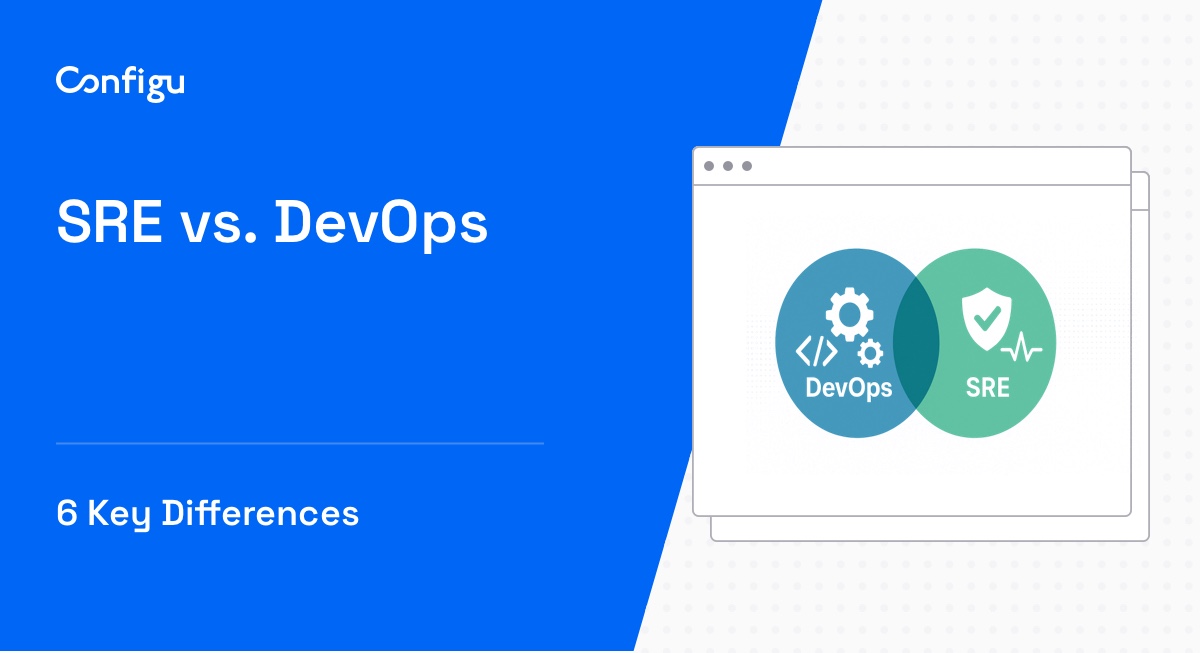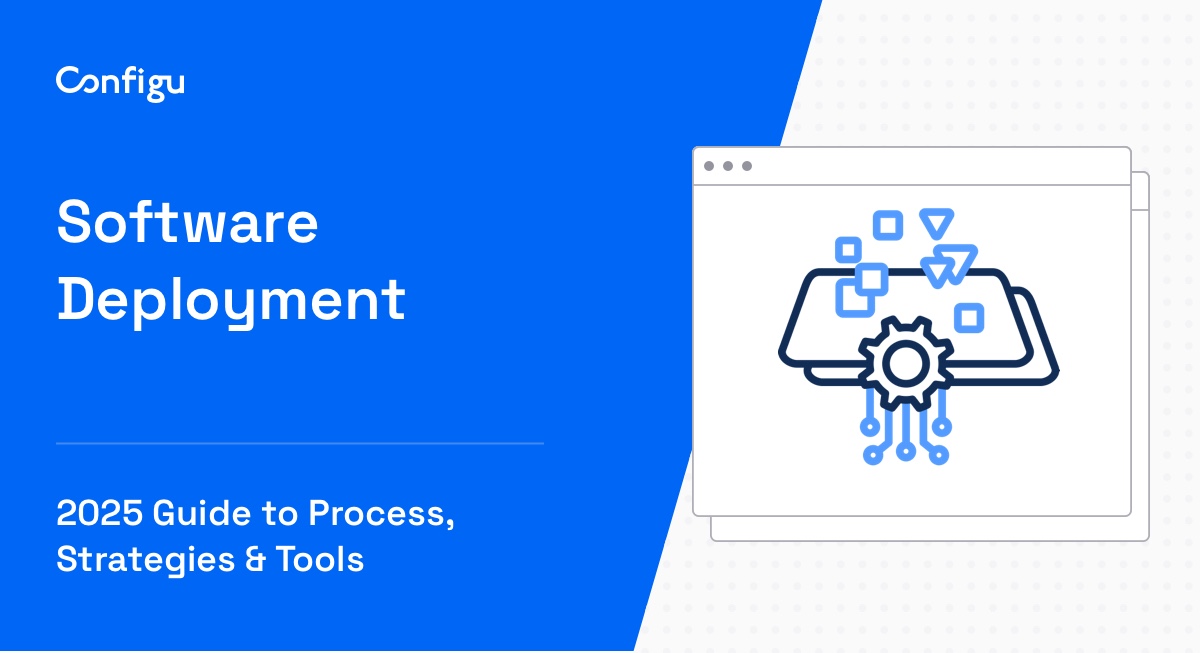What Are the Main DevOps Tool Categories?
DevOps combines software development (Dev) and IT operations (Ops) to improve the speed and quality of software delivery. This methodology integrates processes, tools, and people, simplifying tasks from development to deployment. The primary objective of DevOps is to shorten the development lifecycle while continuously delivering high-quality software.
DevOps teams rely heavily on tools to manage development processes. Here are the most important DevOps tool categories—below we review popular tools in each category:
- Version Control Systems: Enable teams to collaborate efficiently on code development. These tools keep a detailed history of all changes made to the codebase, making it easier to track and identify contributions. Developers can work on separate branches, test new features, and merge changes back into the main codebase, all without disrupting others’ work.
- Continuous Integration Tools: Automate the process of merging code from multiple contributors into a shared repository. These tools run automated tests to ensure that the new code integrates smoothly with the existing codebase. By catching issues early, teams can avoid the “integration hell” that often arises when multiple developers are working simultaneously.
- Configuration Management Tools: Address the challenge of managing environments that must be consistent across development, testing, and production. Instead of manually configuring servers and applications, teams use these tools to define system setups in configuration files.
- Containerization Tools: Encapsulate applications and their dependencies into standardized, lightweight units called containers. These containers are portable, meaning they can run reliably across different environments without compatibility issues.
- Container Orchestration Tools: Automate the deployment, scaling, and management of containers at scale in production environments. They handle tasks like ensuring containers are running in the correct state, distributing workloads across available resources, and restarting containers when failures occur.
- Infrastructure as Code Tools: Transform how teams manage and provision infrastructure by replacing manual processes with code-based definitions. These tools allow teams to describe the desired state of infrastructure components, such as servers, networks, and databases, in a declarative or procedural format.
- Monitoring and Logging Tools: Essential for maintaining the health and performance of applications and infrastructure. Monitoring tools track metrics like CPU usage, memory consumption, and network traffic, providing real-time insights into system behavior.
In this article:
Version Control Systems
1. Git
License: GPL-2.0
Repository: https://github.com/git/git
GitHub stars: 50K+
Contributors: 1.5K+
Git is a version control system that supports distributed workflows. It enables developers to maintain multiple versions of code, aiding in collaboration and project tracking. Git provides features like branching and merging, allowing teams to work in parallel. Its open-source nature and integrations make it a popular choice, powering platforms like GitHub and Bitbucket.
Git’s decentralized architecture allows every developer to have a full-fledged repository locally, which fosters flexibility and speed. Changes can be committed offline and synchronized later. Additionally, Git’s efficiency in handling large projects and non-linear workflows aligns with agile methodologies.
Source: Git
2. Subversion
License: Apache-2.0
Repository: https://github.com/apache/subversion
GitHub stars: 500+
Contributors: 30+
Subversion (often abbreviated as SVN) is a centralized version control system designed to track changes to files and directories over time. Unlike distributed systems like Git, Subversion uses a central repository, making it easier for teams to enforce versioning policies and maintain strict control over access and changes.
Subversion supports atomic commits, ensuring that changes are applied in a single transaction, which prevents incomplete updates. It also handles binary files efficiently, making it suitable for projects that involve non-text assets such as images, videos, or design files. Subversion’s command-line interface and support for third-party tools allow integration into diverse workflows.
Continuous Integration Tools
3. Jenkins
License: MIT
Repository: https://github.com/jenkinsci/jenkins
GitHub stars: 23K+
Contributors: ~800
Jenkins is a widely-used open-source automation server enabling continuous integration and delivery. It supports building, testing, and deploying across multiple platforms and languages. With an ecosystem of plugins, Jenkins adapts to diverse project needs, while its community continually contributes to its development.
Jenkins’s ease of integration with various development tools and cloud platforms supports a seamless software development lifecycle. Its scripting capabilities simplify complex pipeline setups, automating repetitive tasks.
Source: Jenkins
4. GitLab CI/CD
License: Commercial
GitLab CI/CD is an integrated CI/CD tool within the GitLab platform, providing end-to-end automation from code to deployment. It supports all stages of the DevOps lifecycle, enabling teams to manage projects in a single interface. GitLab’s CI/CD capabilities include parallel execution, detailed logging, and customizable pipelines.
GitLab CI/CD fosters rapid iteration and collaboration by offering built-in version control and issue tracking. Its ability to automate testing and deployments reduces time-to-market. The integration with cloud environments and documentation further simplifies setup and usage.
Source: GitLab
5. GitHub Actions
License: MIT
Repository: https://github.com/actions/starter-workflows
GitHub stars: 9K+
Contributors: 300+
GitHub Actions provides automation directly within GitHub, allowing developers to build, test, and deploy code swiftly. Its native integration within GitHub offers seamless CI/CD workflows, leveraging YAML to define automated processes. GitHub Actions quickly scales as project needs evolve, providing flexibility and customization for diverse use cases.
With over 13,000 preconfigured actions, GitHub Actions simplifies complex tasks by leveraging community-contributed solutions. Its workflow visualization aids in tracking and managing CI/CD pipelines.
Source: GitHub
Configuration Management Tools
6. Configu
The Configu Orchestrator is an open source project that implements the concept of Configuration-as-Code with powerful CI/CD integration and other advanced features, such as type validation, version control, managing multiple environments and more.
Check out the GitHub repository. If you like it, give us a ⭐.
7. Ansible
License: GPL-3.0
Repository: https://github.com/ansible/ansible
GitHub stars: 60K+
Contributors: 5K+
Ansible is a configuration management tool known for its simplicity and automation capabilities. Using a declarative language, Ansible allows users to describe infrastructure state, automating complex tasks without requiring agent installation on nodes. It enables the configuration management, application deployment, and task automation processes.
The agentless design of Ansible improves security and efficiency, simplifying operation across various environments. With a strong community and libraries of modules and playbooks, Ansible supports diverse cloud and on-premises solutions. Its capability to integrate with CI/CD pipelines also simplifies the deployment of infrastructure changes.
Source: Ansible
8. Puppet
License: Apache-2.0
Repository: https://github.com/puppetlabs/puppet
GitHub stars: 7K+
Contributors: ~600
Puppet is a tool for automation of configuration management, used to simplify processes of deploying, managing, and scaling applications. With a model-driven approach, Puppet ensures system configurations are maintained, minimizing drift. It uses a declarative language to enforce infrastructure policies consistently, improving system reliability and security.
Puppet’s agent-based architecture manages resources efficiently, scaling with growing business needs. Its ecosystem offers integrations that enable collaboration across diverse platforms. Puppet’s open-source and enterprise editions cater to varied development environments, providing flexibility and control needed for mission-critical deployments.
Source: Puppet
9. Chef
License: Apache-2.0
Repository: https://github.com/chef/chef
GitHub stars: 7K+
Contributors: 600+
Chef is a configuration management tool that automates infrastructure provisioning and resource management. Using a Ruby-based language, Chef scripts infrastructure as code, promoting consistency across environments and improving scalability. Chef supports both agent-based and agentless operations.
Chef’s framework accommodates cloud services and on-premises servers, supporting hybrid architectures. Its ecosystem includes community-contributed cookbooks easing setup and deployment of common applications.
Source: Chef
Tips From the Expert
In my experience, here are tips that can help you maximize the value of DevOps tools:
- Implement toolchains to reduce complexity: Instead of relying on standalone tools, create interconnected toolchains that integrate seamlessly (e.g., Git for version control, Jenkins for CI/CD, and Ansible for configuration management). Toolchains streamline workflows, reduce redundancy, and ensure better collaboration.
- Automate environment-specific configurations: Use tools like Helm (for Kubernetes) or Ansible Vault to manage environment-specific configurations. This ensures consistency across development, staging, and production while reducing errors caused by manual adjustments.
- Evaluate tools based on interoperability: Choose tools that integrate well with the existing stack. For example, Prometheus pairs naturally with Grafana for monitoring, and GitHub Actions integrates smoothly with repositories. Interoperability prevents disruptions and accelerates adoption.
- Adopt dynamic credential management: Use secret management tools like HashiCorp Vault or AWS Secrets Manager to handle credentials dynamically. These tools minimize security risks by rotating secrets and eliminating hard-coded credentials.
- Focus on observability over just monitoring: Move beyond traditional monitoring by integrating observability practices. Tools like OpenTelemetry collect traces, metrics, and logs across systems, providing a unified view of application health and performance.
Containerization Tools
10. Docker
License: Apache-2.0
Repository: https://github.com/docker/compose
GitHub stars: 32K+
Contributors: 400+
Docker is a containerization platform that simplifies the creation, deployment, and management of applications within containers. Containers package applications with their dependencies, ensuring consistency across environments. Docker’s open-source nature and community support contribute to its widespread adoption for software development.
The Docker ecosystem, including Docker Hub and Docker Compose, accelerates development workflows and simplifies dependency management. It provides lightweight, isolated environments for application testing, enabling rapid iteration. Docker’s efficient resource usage improves scalability, enabling applications to run on various infrastructure configurations.
Source: Docker
11. Podman
License: Apache-2.0
Repository: https://github.com/containers/podman
GitHub stars: 24K+
Contributors: 600+
Podman is a container management tool providing a daemonless alternative to Docker, with a lightweight and secure way to manage containerized applications. Unlike Docker, Podman does not require a central daemon, which eliminates a single point of failure and improves system stability.
Podman uses a rootless architecture by default, improving security by enabling non-privileged users to create and manage containers. Podman is compatible with the Open Container Initiative (OCI) standards, ensuring interoperability with container images created using Docker. It supports features like pod management, allowing users to group containers that share the same network and storage.
Source: Podman
12. LXC (Linux Containers)
License: GPL-2.0
Repository: https://github.com/lxc/lxc
GitHub stars: 4K+
Contributors: 300+
Linux Containers (LXC) is a lightweight virtualization technology that provides operating system-level isolation for running multiple instances of Linux on a single host. LXC leverages kernel features like cgroups and namespaces to isolate processes, ensuring that containers remain independent from one another while sharing the host’s kernel.
Unlike container runtimes like Docker or Podman, which focus on application-level containers, LXC offers system containers capable of running a full Linux distribution. This makes LXC particularly suited for scenarios like virtual hosting, testing operating systems, or managing workloads that require high performance without the overhead of traditional virtual machines.
Source: LXC
Container Orchestration Tools
13. Kubernetes
License: Apache-2.0
Repository: https://github.com/kubernetes/kubernetes
GitHub stars: 100K+
Contributors: 3K+
Kubernetes is an open-source container orchestration platform that automates the deployment, scaling, and management of containerized applications. It offers a framework for running distributed systems resiliently, ensuring application reliability across clusters. Kubernetes handles workload balance, self-healing of failed nodes, and automated rollouts.
The Kubernetes ecosystem, improved by third-party integrations, boosts functionality and adaptability, catering to diverse operation needs. Its multi-cloud and hybrid deployment support make Kubernetes a suitable choice for managing complex applications.
Source: Kubernetes
14. Docker Swarm
License: Apache-2.0
Repository: https://github.com/moby/swarmkit
GitHub stars: 3K+
Contributors: 100+
Docker Swarm is a native container orchestration tool integrated into the Docker ecosystem, used for managing and scaling containerized applications. It enables developers familiar with Docker commands and workflows to create a cluster of Docker nodes, where containers are deployed and managed as services.
Swarm supports features like load balancing, where incoming requests to a service are automatically distributed across available containers. It also offers high availability by replicating services across nodes, ensuring that workloads continue to run even if a node fails. Declarative service definitions allow users to specify desired states.
Source: Docker Swarm
Infrastructure as Code Tools
15. Terraform
License: Business Source License
Repository: https://github.com/hashicorp/terraform
GitHub stars: 42K+
Contributors: 1K+
Terraform is an open-source IaC tool that enables the management of infrastructure resources across multiple cloud providers through declarative configuration files. It automates the lifecycle management of infrastructure, promoting consistency and reproducibility of environments. Terraform’s modular code structure supports infrastructure changes with minimal disruptions.
Terraform’s state management capabilities track resource changes, providing visibility into infrastructure status. Its infrastructure-as-code approach ensures efficient resource provisioning and scales with evolving requirements.
Source: Terraform
16. Pulumi
License: Apache-2.0
Repository: https://github.com/pulumi/pulumi
GitHub stars: 22K+
Contributors: 200+
Pulumi is an IaC platform that leverages familiar programming languages for infrastructure definition, improving developer productivity and reducing learning curves. Its coding-centric approach allows developers to utilize languages like Python, TypeScript, and Go to define and manage infrastructure, fostering customization and control over deployment processes.
Pulumi supports multiple cloud providers, enabling hybrid cloud strategies and integration with existing DevOps workflows. By allowing coding rigor within infrastructure scripts, Pulumi promotes better modularization and reuse. Its state management and real-time updates feature further improve operational visibility.
Source: Pulumi
17. AWS CloudFormation
License: MIT
Repository: https://github.com/aws-cloudformation/cfn-lint
GitHub stars: 2K+
Contributors: 100+
AWS CloudFormation is an IaC service that simplifies the management, provisioning, and deployment of cloud resources. Using YAML or JSON templates, developers can define a range of AWS services and their configurations in a declarative manner. CloudFormation automates the process of creating, updating, and deleting resources.
CloudFormation can manage resources as stacks, allowing users to group related resources and treat them as a single unit. This enables efficient management of complex infrastructures, such as multi-tier applications or distributed systems. The service also supports drift detection, enabling users to identify and address deviations from the intended configuration.
Source: Amazon
Monitoring and Logging Tools
18. Prometheus
License: Apache-2.0
Repository: https://github.com/prometheus/prometheus
GitHub stars: 56K+
Contributors: 900+
Prometheus is an open-source monitoring system that collects and stores metrics from configured targets at specified intervals. It features a query language, PromQL, and integrates with Grafana for in-depth visualization of collected metrics. Its alerting mechanism enables proactive response to anomalies.
Prometheus’s time-series database efficiently handles multi-dimensional data, supporting monitoring across distributed systems. It fosters insights into application performance by providing rich data and context for diagnosing issues. Its modular architecture and documentation make it adaptable for various use cases.
Source: Prometheus
19. Grafana
License: AGPL-3.0
Repository: https://github.com/grafana/grafana
GitHub stars: 65K+
Contributors: 2K+
Grafana is an open-source analytics and monitoring solution, known for its interactive dashboards that visualize system metrics and logs across diverse data sources. Its integration with Prometheus, Elasticsearch, and other databases improves data accessibility and comprehensiveness.
The customizable interface and alerting capabilities of Grafana allow for tailored monitoring solutions that meet organizational requirements. As a result, Grafana elevates DevOps strategies by providing clear visibility into system performance issues, enabling proactive management, and supporting the optimization of resources and processes.
Source: Grafana
20. ELK Stack (Elasticsearch, Logstash, Kibana)
License: MIT
Repository: https://github.com/deviantony/docker-elk
GitHub stars: 17K+
Contributors: 60+
The ELK Stack—comprising Elasticsearch, Logstash, and Kibana—provides a suite for logging and analyzing system data. Elasticsearch offers distributed search capabilities, Logstash collects and processes logs, and Kibana provides an interface for exploring and visualizing data. This combination enables insights into application performance and operational issues.
With its scalable and flexible architecture, the ELK Stack supports diverse logging requirements, accommodating large volumes of data. It supports detailed analysis and centralized data management, aiding in swift issue resolution and continuous improvement.
Source: Elastic
Choosing the Right DevOps Tools for Your Team
Selecting the appropriate DevOps tools requires evaluating several factors to ensure they align with the team’s workflows, goals, and infrastructure. Here are key considerations to guide the decision-making process:
- Understand your team’s requirements: Assess the team’s needs, including the scale of projects, existing workflows, and technical expertise. For example, small teams might prefer tools with intuitive interfaces and low setup complexity, while larger teams handling diverse environments may need highly customizable and scalable solutions.
- Integration with existing systems: Compatibility with the current technology stack is essential. Ensure the tools integrate seamlessly with existing version control systems, CI/CD pipelines, and cloud providers to avoid disrupting workflows and maximize efficiency.
- Scalability and flexibility: Choose tools that can scale with the organization’s growth. For example, container orchestration tools like Kubernetes are useful for handling large-scale applications, whereas simpler tools like Docker Swarm may be enough for smaller deployments.
- Community support and documentation: Opt for tools with active communities and extensive documentation. These resources can significantly reduce troubleshooting time, foster learning, and provide valuable plugins or modules contributed by the community.
- Security and compliance: Evaluate the tools’ security features and ensure they align with the organization’s compliance requirements. Features like role-based access control (RBAC), encryption, and audit logging are critical for maintaining a secure environment.
- Cost and licensing: Analyze the cost of adopting and maintaining the tools. Open-source solutions like Terraform or Prometheus can lower upfront costs, but enterprise-grade tools with licensing fees, such as AWS CloudFormation or Puppet Enterprise, might offer advanced features and dedicated support.
Trial and prototyping: Before fully adopting a tool, test it in a controlled environment. Prototyping allows the team to evaluate usability, performance, and integration capabilities without committing significant resources.



